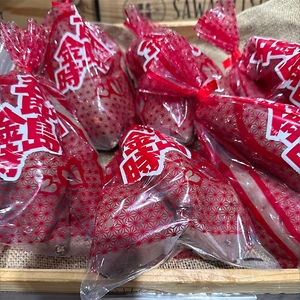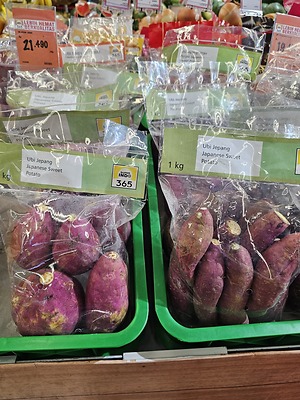


Gorojima Sweet Potatoes
Estimated Inventory, lb : 0
Description/Taste
Gorojima sweet potatoes are medium to large in size and are long, slender, oblong, and somewhat uniform in shape with tapered ends. The skin is rich mahogany to red and is smooth and firm with many medium-set eyes strewn across the surface. The flesh is creamy white to ivory with a dense and floury-texture. When cooked, Gorojima sweet potatoes are soft with a sweet and earthy flavor with nuances of roasted chestnuts.
Seasons/Availability
Gorojima sweet potatoes are available from the late fall to early spring.
Current Facts
Gorojima sweet potatoes, botanically classified as Ipomoea batatas, are part of the Koukei No. 14 breed, a sweet potato brand from the Tokushima prefecture in Japan. Also known as Gorojima Kintoki, Gorojima kidney, and Red kidney, Gorojima sweet potatoes are members of the Convolvulaceae or morning glory family. In Japan, sweet potatoes are classified into two different categories which consist of floury textured varieties or moist, viscous textured varieties. Gorojima sweet potatoes are a floury variety and are considered to be the most famous vegetable of the Kaga-Yasai group, which is a group of fifteen different species of produce grown in Kanazawa, Japan through a traditional, natural process.
Nutritional Value
Gorojima sweet potatoes provide dietary fiber, beta carotene, B vitamins, calcium, vitamin C, and iron.
Applications
Gorojima sweet potatoes are best suited for cooked applications such as roasting, steaming, baking, and frying. Gorojima sweet potatoes can be used in both sweet and savory preparations, and the exceptionally sweet flavor and soft texture of cooked Gorojima make it a choice potato for dessert. Gorojima sweet potatoes can also be cooked and pureed to make soups, ice cream, custards, pastries, croquettes, or a filling for pies and tarts. Gorojima sweet potatoes pair well with naan bread, butternut squash, arugula, red onion, garlic, pecorino cheese, Brussel sprouts, kale, hummus, black beans, ricotta cheese, and corn. Store Gorojima sweet potatoes in a cool, dark, and dry place. Refrigeration should be avoided as it can cause potatoes to spoil prematurely.
Ethnic/Cultural Info
In Japan, it is believed that in 1706, Lord Maeda told the people of the Gorojima village that there was a crop of sweet potatoes that could be grown in barren dunes and the people of Satsuma were cultivating them on their barren land. Legend has it that the officer of the Gorojima village, Taroemon, infiltrated Satsuma, hid a sweet potato in his topknot and brought it back to the Gorojima village to grow there. Gorojima growers have used a specially formulated fertilizer made from rice bran to grow the sweet potatoes for the past three hundred years.
Geography/History
Gorojima sweet potatoes are believed to have originated in Japan, but its history is largely unknown. Today, Gorojima sweet potatoes are produced mainly in Kanazawa-shi, the Gorojima Kurigasaki district of Ishikawa prefecture, Japan. Gorojima, located adjacent to the Sea of Japan, has a sand dune terrain ideal for the growing the sweet potato. These sand dunes are perfectly sized and provide excellent water retention and air permeability. Today Gorojima sweet potatoes are predominately found at local markets in Japan.
Recipe Ideas
Recipes that include Gorojima Sweet Potatoes. One
| Pinch of Yum |
|
Roasted Sweet Potatoes & Hummus |
| Love & Lemons |
|
Mini Sweet Potato Pizzas |
| Pinch of Yum |
|
Arepas with Carnitas and Sweet Potato |
| Pinch of Yum |
|
Healthy Grilled Sweet Potato Nachos |









